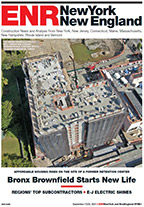The coalition—made up of the Associated General Contractors, National Association of Home Builders, American Subcontractors Association and American Road and Transportation Builders Association, among others—notes that 1.5 million construction workers were omitted from the agency’s assessment of the affected work force.
It pegs compliance costs at least four times greater than OSHA’s estimate. The CISC, as a result, has requested that OSHA withdraw its proposed rule until industry concerns are met. Post-hearing comments are being accepted through July 18; a final rule date has yet to be issued.
“Every year this rule is delayed, another 60 workers will die,” says Margaret “Peg” Seminario, director of safety and health for the AFL-CIO. “That’s deaths. That’s not even looking at the numbers of workers who will become sick. We still have thousands of new cases of silicosis every year in this country.”
Implementation of the standard faces several hurdles, however, such as weather, which can change silica exposure boundaries every time the wind blows. Multi-employer jobsites are another challenge because all workers aren’t necessarily under control of the contractor overseeing the area, says Kevin P. Turner, safety manager for Hunt Construction Group’s Indianapolis-based Eastern Division.
“Unlike other health hazards that have been regulated by OSHA in the construction industry, like asbestos and lead, silica is prevalent to a certain degree in almost every job on a construction site,” says Mammock. “It is part of what nearly all construction employers must deal with day in and day out in virtually every work task for every employee.”
Over the last decade, more tool suppliers have introduced dust-capturing controls, namely exhaust ventilation and wet methods for drills, chop saws, hammers and grinders. Once a retrofit, new dust extractors are often sold with many tools. They are more portable, accepting a HEPA filter, but also more pricey. The filter eliminates the need for a vacuum hook-up, while adding up to $250 to the cost of a tool. Hilti Inc., Tulsa, offers dust removers and vacs, wet and dry, for dozens of tools. The shrouds can double the cost of smaller tools, like grinders, but save money on clean-up, health benefits and compliance fines.
Dust Control Technology, Peoria, Ill., offers larger-sized solutions, too, with a “DustBoss” machine that atomizes water to ultra-fine droplets for greater particle attraction over a 280,000-sq-ft area. The DB-100 sprays water at 200 psi with droplets sized at 50 to 200 microns, oscillating 359º at 1/8-hp, with an adjustable angle height of -7º to 45º. But it still may not be enough.
“While no visible dust is a lofty goal, it has no basis in reality in the construction environment,” says Kellie Vasquez, vice president of Holes Inc., Houston. “Rarely, if ever, will there be absolutely no visible dust emitted from a silica-generating activity with the use of wet methods or other engineering controls.”

